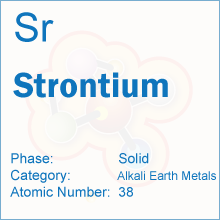 Periodic Table -> Strontium
Periodic Table -> StrontiumStrontium
Strontium DetailsStrontium Symbol: Sr
Strontium Atomic Number: 38
Strontium Atomic Weight: 87.62
What is Strontium?
Strontium (atomic number 38, symbol Sr) is an alkaline earth metal that is commercially available. Its chemical and physical properties are similar to that of elements such as barium and calcium. It was discovered in 1790 by the Scottish chemist William Cruickshank and the physician and chemist Adair Crawford.
Properties
The element reacts vigorously when in contact with water and tarnishes in air. With water, it forms hydrogen gas and strontium hydroxide, which is a caustic alkali, causing severe lung, eye, and skin irritation. There are two oxidation states - 1 and 2 - and 4 stable isotopes - Sr-88, Sr-87, Sr-86, and Sr-84. In general, the radioactive isotopes of the element share the same properties. The properties of Sr-90 are similar to that of calcium. The element also forms compounds such as carbonates and nitrates, including strontium nitrate and carbonate.
Commercial Applications and Uses
There are different applications of strontium and its compounds, including strontium barium niobate, renelate, oxide, aluminate, and titanite. The latter is used in the optics industry and in thermoelectric generators. Strontium oxide is another compound that is used to enhance pottery glazes. The element and its isotopes also have applications. Sr-90, for example, is used for cancer treatment. It is also used in agricultural and medical research and to manufacture portable power devices. They are especially useful in spacecraft, weather stations, navigational beacons, and remote locations with no power supply. In addition, it is added to industrial gauges and electron tubes. Sr-89 is used in therapies for metastatic bone cancer. Strontium chloride, which is a salt, is used in research and for dental care. Strontium ranelate prevents bone loss and facilitates bone tissue formation. It is used in therapies and treatments intended for patients with osteoporosis. Research also shows that some of its radioactive forms eliminate cancer cells. Other studies suggest that the element can be used to treat osteoporosis and increase bone density, to prevent cavities, and to improve cartilage metabolism. Thus, it can be used in therapies intended for patients with arthritis.

The element occurs in the form of carbonate strontianite and celestite and is found in mining sites in Spain, Turkey, Mexico, and the United Kingdom. Sr-90 is an isotope and a byproduct of plutonium and uranium processing in nuclear reactors. It is also found in nuclear waste and contributes to pollution.
Health Effects and Hazards
Some of its isotopes are radioactive, for example, Sr-90 and increase the risk for bone cancer and other bone disorders. Exposure occurs through drinking, eating, inhalation, dust, and skin contact. Significant amounts of Sr-90 were released in the atmosphere after the Chernobyl accident. While strontium is dissolved in water, small amounts accumulate in soils and remain there for many years. The element is rarely found in drinking water. Radioactive leaks and nuclear weapon tests are potential hazards.
Water-soluble strontium is also a health hazard in that it can be found in drinking water. Foods that contain higher concentrations include dairies, green leafy vegetables, grains, and others. Sr-90 is found in milk. Vegetables that contain significant amounts of strontium include celery, potatoes, beans, peas, carrots, lettuce, and others. California cabbage and lettuce contain Sr-90. The amount is insignificant which makes consumption safe. Overexposure is associated with side effects such as fainting, blood clots, skin irritation, nausea, and others. Strontium chromate is one compound that is considered a health hazard because of its toxic properties. Research shows that chronic exposure increases the risk for lung cancer. Strontium bursts into flame when in contact with air and for this reason, kerosene is used for storage.
You can
link to this page, using the code below:
Periodic Table |
Banks
© ElementsDatabase.com 2015 | Privacy | About | Contact